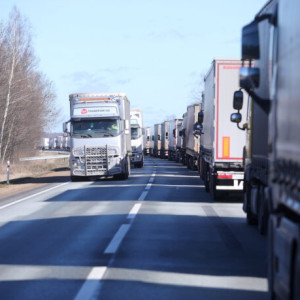Latvia raises road user fees for freight transport


Starting with the 1st of January next year, Latvia will increase most road user charges (vignettes) for freight vehicles over three tons, the government decided on Tuesday. The Ministry of Transport explained that the aim of the amendments is to set vignette rates that reflect the actual cost of maintaining infrastructure, taking into account the impact of freight transport on roads. The changes include introducing a "zero" rate for zero-emission vehicles and setting differentiated rates for emission-producing vehicles depending on their emissions level.
The amendments will also expand the road network subject to the road user charge, including regional roads that run parallel to main national highways or lead to ports. The purpose is to prevent drivers from avoiding fees by deliberately choosing routes outside the current toll network. In Latvia, the road user charge applies to heavy freight vehicles with a maximum gross weight above three tons using national main and regional roads designated as toll roads.
The fee is differentiated based on vehicle weight, axle count, emission class, and usage period.
Revenues from the toll are directed toward maintaining and developing the national roads where the fees are collected.
Until now, vehicles and combinations with a gross weight of 3.5 to 12 tons and engine emission class "Euro 0, I, II" had to pay 15 euros for a daily vignette, 37 euros for a weekly vignette, 74 euros for a monthly vignette, and 760 euros for an annual vignette. Going forward, these rates will increase to 17 euros, 43 euros, 87 euros, and 870 euros, respectively. For lighter vehicles (3.001 to 3.5 tons) with "Euro VI or less polluting" engines, the daily vignette will rise from 5 euros to 7 euros, while the weekly vignette will go from 12 euros to 18 euros.
The ministry emphasized that despite the toll, freight road transport continues to dominate Latvia's transit and domestic logistics flows, especially heavy vehicles with high axle loads that accelerate road damage. Freight volumes on roads continue to rise, increasing both infrastructure wear and harmful emissions. Meanwhile,
Latvia's railway system still has free capacity, and its existing infrastructure could handle more freight.
However, the relatively lower cost of road transport compared to rail discourages businesses from choosing the more environmentally friendly option.
To encourage sustainable transport, the Ministry of Transport is promoting the development of "dry port" hubs--logistics centers located inland where cargo could be transferred from road to rail. Transport Minister Atis Svinka (P) noted that the quality of regional roads is deteriorating due to dishonest practices. "Unfortunately, we face situations where freight vehicles, to avoid buying vignettes, use regional roads instead of main national highways.
These roads are damaged because they cannot handle the extra load, and restoring their quality requires additional funding," the minister said. He added that by expanding the toll network, opportunities to avoid paying will be reduced, and freight will move onto more suitable main roads. At the same time, the new vignette rates will encourage the use of environmentally friendly vehicles.
As reported, amendments to the Road User Charge Law will take effect on the 1st of January, 2025, increasing most vignette rates for freight vehicles over three tons. Larger increases apply to more polluting vehicles and shorter-term vignettes, while more ecological trucks will pay lower annual fees. The changes also introduce a new nine-month vignette option, designed to reduce administrative burdens during the harvest season.
Read also: Aseradens considers Latvia's 2026 state budget "very, very good"[1]
Follow us on Facebook[2] and X!
References
- ^ Read also: Aseradens considers Latvia's 2026 state budget "very, very good" (bnn-news.com)
- ^ Facebook (www.facebook.com)